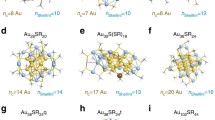Abstract
Small metal clusters, like Au55(PPh3)12Cl6, which fall in the size regime of 1–2 nm are colloidal nanoparticles with quantum properties in the transitional range between metals and semiconductors. These chemically tailored quantum dots show by the Quantum Size Effect (QSE) a level splitting between 20 and 100 meV, increasing from small particle sizes to the molecular state. The organic ligand shell surrounding the cluster acts like a dielectric “spacer” generating capacitances between neighboring clusters down to 10−18F. Therefore, charging effects superposed by level spacing effects can be observed. The ligand-stabilized colloidal quantum dots in condensed state can be described as a novel kind of artificial solid with extremely narrow mini or hopping bands depending on the chemically adjustable thickness of the ligand shell and its properties. Since its discovery, the Single Electron Tunneling (SET) effect has been recognized to be the fundamental concept for ultimate miniaturization in microelectronics. The controlled transport of charge carriers in arrangements of ligand-stabilized clusters has been observed already at room temperature through Impedance Spectroscopy (IS) and Scanning Tunneling Spectroscopy (STS). This reveals future directions with new concepts for the realization of simple devices for Single Electron Logic (SEL).
Part II presents models and connections between microscopic and macroscopic level, regardless of whether there already exist suitable nanoscale metal cluster compounds, and is aimed at the ultimate properties for a possible application in microelectronics.
Similar content being viewed by others
References
Schön G, Simon U (1995) Prog Colloid Poly Sci (in press)
Penzar Z, Ekardt W (1990) Z Phys D 17:69–72
Genzken O, Brack M, Chabant E, Meyer J (1992) Ber Bunsenges Phys Chem no 9 96:1217–1220
Balian R, Bloch C (1971) Ann Phys (N.Y.) 69:76
Ozin GA, Bowes CL, Steele M (1992) Mater Res Soc Symp Ser Macromolecular Host-Guest Inclusion Complexes (in press); Ozin GA (1992) Nanomaterials: Endo- and Exosemiconductors, Adv Chem Ser, A.C.S., Washington D.C.
Reed M (1993) Spekt d Wiss 3:52–57
Cohen ML (1986) Proc 1st NEC Symp, Hakone and Kawasaki, Japan, p. 2–10
Schmid G, Schön G, Simon U (1992) German Patent pending No 42-12220
Schmid G, Schön G, Simon U (1992) USA Patent pending No 08/041,239
Simon U (1992) PhD Thesis University of Essen, Germany
Mielke F, Houbertz R, Hartmann U, Simon U, Schön G, Schmid G (1994) Europhys Lett (in press)
Schmid G (1992) Chem Rev 92:1709–1727; Schmid G (ed) (1994), VCH, Weinheim (Germany)
Schmid G, Lehnert A, Malm J-O, Bovin J-O (1991) Angew Chem Int Ed Engl 30:852
Simon U, Schön G, Schmid G (1993) Angew Chem Int Ed Engl No 2 32:250–254
Mielke F, Houbertz R, Hartmann U, Simon U, Schön G, Schmid G (1995) (to be published)
Vogel W, Rosner B, Tesche B (1993) J Phys Chem 97:11611–11616
Smit HHA, Thiel RC, de Jongh LJ, Schmid G, Klein N (1988) Sol St Com 65:915
Fairbanks MC, Benfield RE, Newport RJ, Schmid G (1990) Sol St Comm 74:431
Marcus MA, Andrews MP, Zegenhagen J, Bommannavar AS, Montano P (1990) Phys Rev B 42:3312
Fenske D (private communication), Diploma Thesis University of Karlsruhe, FRG
Macdonald JR (1987) Impedance Spectroscopy, John Wiley & Sons, New York
van Dijk T, Burggraaf A (1981) Phys Stat Sol a 63:229–240
Schouler JL (1979) PhD Thesis Institut National Polytechnique de Grenoble, France
Bauerle JE (1969) J Phys Chem Solids 30:2657–2670
Simon U, Schmid G, Schön G (1992) Mat Res Symp Proc Vol 272:167–175
Möhrke C (1993) PhD Thesis University of Essen, Germany
Schmid G (to be published)
Smokers RTM (1992) PhD Thesis University of Nijmegen, The Netherlands
Zorin AB (1993) (to be published)
Schön G (1994) Spektr d Wiss 4:22–24
Kolbert AC, de Groot HJM, van der Putten D, Brom HB, de Jongh LJ, Schmid G, Krautscheid H, Fenske D (1992) submitted to Z Phys D
Kreibig U, Fauth K, Granqvist C-G, Schmid G (1990) Z Phys Chem 169:11–28
Peschel S (1993) Diploma Thesis University of Essen, FRG
Funke K (1991) Ber Bunsenges Phys Chem 9:955–964
van Staveren MPJ, Brom HB, de Jongh LJ (1991) Physics Reports 208:1–96
Licharev KK, Zorin AB (1985) J Low Temp Phys 59:347
Gladun A, Zorin AB (1992) Phys i u Z No 4 23:159–165
Ozin GA (1992) Adv Mater No 10 4:612–649
Deutscher G, Levy YE, Ryazantzev IA, Dravin VA, Yakimov AI (1986) Europhys Lett 4:577
Hartman TE (1986) J Appl Phys No 4 34:943–947
Schönenberger C, van Houten H, Donkersloot HC (1992) Europhys Lett 20 (3):249–254
Nejoh H, Aono M (1993) Jpn J Appl Phys No 1B 32:532–535
Averin DV, Register LF, Licharev KK Hess K (1993) submitted to J Appl Phys
Schmid G (1993) (to be published)
Chi LF, Johnston RR, Ringsdorf H (1992) Thin Film Solids 210/211:211; (1992) Langmuir 8:1360; Chi LF, Anders M, Fuchs H, Johnston RR, Ringsdorf H (1993) Science 259:213
Becker C, Fries Th, Wandelt K, Kreibig U, Schmid G (1991) J Vac Sci Technol B9 2:810–813
von Klitzing K, Schmid G (1994) unpublished work
Binnig G, Rohrer H, Gerber Ch, Weibel E (1982) Appl Phys Lett 40:178; Chen J (1993) Introduction to Scanning Tunneling Microscopy, Oxford University Press, New York
Licharev KK, Claeson T (1992) Spektr d Wiss 8:62–67
Koch H, Lübbig H (eds) (1992) Single-Electron Tunneling and Mesoscopic Devices, Springer, Berlin Heidelberg
Grabert H (ed) (1991) Z Phys B (Special Issue on Single Charge Tunneling) No 3:85
Corcoran E (1992) Spekt d Wiss (Sonderheft 11) 1:76
Wang Y, Herron N, Mahler W, Suna A (1989) J Opt Soc Am B Vol 6 No 4:808–813
Fink J, Sohmen E (1992) Phys Bl No1 48:11–15
Hamann C, Burghardt H, Frauenheim T (1988); Ebeling W, Weißmantel Ch (eds), VEB, Berlin, 101–119
Author information
Authors and Affiliations
Rights and permissions
About this article
Cite this article
Schön, G., Simon, U. A fascinating new field in colloid science: small ligand-stabilized metal clusters and their possible application in microelectronics. Colloid Polym Sci 273, 202–218 (1995). https://doi.org/10.1007/BF00657826
Received:
Accepted:
Issue Date:
DOI: https://doi.org/10.1007/BF00657826




